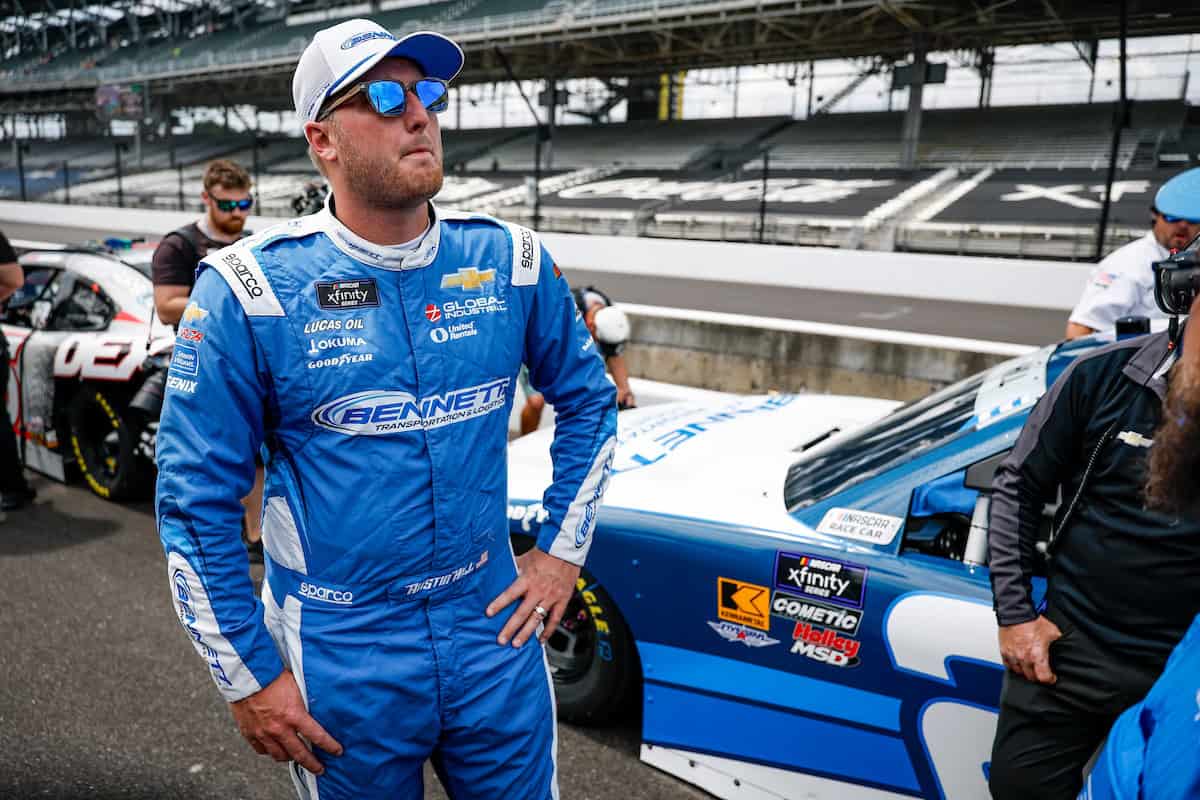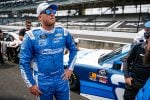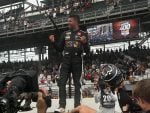1. Was Austin Hill’s penalty for turning Aric Almirola too harsh, too light or just right?
Andrew Stoddard: NASCAR has been inconsistent with its officiating at times, but it got this one right. Based on the precedent set in 2022 with Bubba Wallace and 2023 with Chase Elliott, a one-race suspension for Austin Hill was warranted. I could’ve seen Hill getting a slightly bigger suspension as he’s had more issues with his temper in the past, such as spinning out Cole Custer under caution during a NASCAR Xfinity Series race at Charlotte Motor Speedway last season. But ultimately, the punishment fits the crime, and we’ll see if Hill’s on-track demeanor changes at all after sitting out this weekend at Iowa Speedway.
Christopher Hansen: The one-race suspension for Hill fits the crime. At the high-speed racetracks, right-rear hooking another driver at speeds over 180 mph is unacceptable. NASCAR has been consistent in its judgments of incidents at similar tracks in the past. I would like to see a little more consistency moving forward when it comes to right hooking another driver in general so that the same rules apply on all track types, even at road courses. Despite road courses having slower speeds than traditional oval tracks, any intent to right hook a driver should be assessed with at least a one-race suspension to send a clear message that this will not be tolerated for anyone that does this in the future.
Aaron Bearden: Just right. A week off feels justified given the severity of the crash, and he’ll appropriately suffer the repercussions throughout the playoffs. If anything, I’d say NASCAR got the call wrong on Austin Cindric earlier this year in the NASCAR Cup Series. There has to be an appropriate disincentive to keep drivers from making these dangerous, irresponsible decisions in the heat of the moment.
Mark Kristl: Just right. If you intentionally wreck someone, it should be a one-race suspension. NASCAR botched it when Cindric intentionally wrecked Ty Dillon at Circuit of the Americas earlier this year, but it got it right here. Aggression and payback are one thing that the garage should self-police. Wrecking someone intentionally, though, is crossing the line. People can get hurt, there is the large financial cost and other drivers can get collected via no fault of their own.
2. Now that the inaugural In-Season Challenge is done, what worked well and what improvements/changes should NASCAR make?
Hansen: One of the first things I’d change with the In-Season Challenge is not starting the tournament at a drafting style track like they did at EchoPark Speedway this year. After Atlanta, there wasn’t a single perfect bracket left after the Big One wiped out a lot of this year’s top seeds. The tournament did a decent job of shining the spotlight on some of the drivers that otherwise might not have been mentioned, like Dillon. The overall look to the tournament where drivers face off head-to-head, along with having a separate altcast that focused only on the drivers and the individual matchups, should be brought back in future editions.
Kristl: What worked well was that we got more focus on Ty Gibbs and Dillon than we would have otherwise. Too often, TV broadcasts ignore drivers. This allowed drivers who advanced throughout each round to have the spotlight thrust upon them. What failed was everything else. The formula for seeding seemed convoluted; full-timer Shane van Gisbergen was not in the competition. Denny Hamlin and Bubba Wallace won races after they were eliminated. The In-Season Challenge is not worth renewing. It had merit as a concept, but it failed in reality.
Bearden: The tournament was fine, if nothing special. Starting with a track other than Atlanta and/or a change in the seeding process would do the series some good. Too many of the heavyweights got knocked out early, and the tournament felt rushed with the quick build. NASCAR should throw in every full-time driver and make the opening round a group stage like the NBA’s In-Season Tournament and the FIFA World Cup do. Have grouped drivers run at four different track types throughout the spring and give the top driver in each group a spot in the tournament. Give final spots for a field of 16 out in a last chance qualifier-style race at Atlanta to open TNT’s slate and then proceed with the four elimination rounds.
Stoddard: The In-Season Challenge added some intrigue and fresh plotlines to a summer stretch of the Cup Series that is usually a little more subdued before the final leadup to the playoffs. It gave us a feel-good story in the Cinderella run of Dillon and the No. 10 Kaulig Racing team. It should come back next year but with some changes, mainly to the schedule of racetracks. The In-Season Challenge should not start or finish with a drafting track like EchoPark. The Big One in Atlanta took out a lot of big names and diminished some of the initial buzz. NASCAR also needs to make sure there is a good variety of tracks in the five-race challenge, with shorter ovals, longer ovals and just one road or street course.
3. With four regular season races left and 13 winners, how many Cup playoff spots will be taken by drivers on points?
Kristl: There will be two playoff drivers via points. Iowa Speedway and Richmond Raceway will have repeat winners, and good luck beating van Gisbergen at Watkins Glen International. That leaves Daytona International Speedway. Because someone will get overly aggressive too early in that race, there will be the Big One. As a result of a depleted field, someone else will win their way into the playoffs.
Bearden: I’d say two. Someone will squeak out a win in the final four weeks, likely at Daytona. Tyler Reddick will sneak through if he doesn’t win, and Alex Bowman will probably take the last spot. Sorry, RFK Racing fans.
Stoddard: Two drivers will make the Cup playoffs on points: Reddick and Bowman. Reddick enters Iowa with a cozy 138-point gap on the cut line, more than two races’ worth of points. It would take three new winners in the next month to knock him out. At 63 points above the cut line, Bowman is in not nearly as comfortable a position as Reddick; however, the No. 48 has been turning a corner of late. Following just one top-10 finish during the five races on Amazon Prime Video, Bowman rattled off four top 10s during the five races on TNT. A new winner will emerge from a chaotic regular season finale at Daytona, but Reddick and Bowman will be safe.
Hansen: Two drivers making the playoffs on points is a safe bet. Of the four remaining regular-season races, Daytona is the one true wild card race that could see a driver outside the playoffs win their way in like Harrison Burton did in 2024. I could see Watkins Glen potentially being the other wildcard race, only if van Gisbergen has some sort of issues during the race that takes him out of contention. In Iowa and Richmond, we should see the usual suspects (Kyle Larson, Hamlin, Ryan Blaney, etc.) running up front and competing for those race wins. But with this current playoff format, there is still room for four different winners over the next four races heading into the postseason.
4. What impact does the Brickyard 400 win have on Bubba Wallace’s Cup career/legacy?
Bearden: This win was huge for Wallace and the No. 23 team — arguably more impressive than even a Daytona 500 would have been. You rarely get a chance to fluke a win at the Brickyard. 23XI Racing had to execute all weekend to have a chance, qualifying on the front row and running close enough to the lead to use the final pit cycle to get to the front. Wallace and his team showed they can deliver on the grandest stage amid significant pressure. Now, they’ll always be winners of a crown jewel race.
Stoddard: The Brickyard 400 may not have the same luster as years past, but Indianapolis Motor Speedway still maintains a great deal of prestige. A victory at Indy will serve as a resume builder and confidence booster for Wallace, who seems to have stepped into a more mature team leader role at 23XI this season. Time will tell if this win opens the floodgates for Wallace to add more checkered flags to his Cup total. The outcome of the lawsuit between 23XI and NASCAR will play a part in that as well.
Hansen: To date, Sunday’s Brickyard 400 victory is the biggest win of Wallace’s Cup career, aside from his first win in 2021 at Talladega Superspeedway to become the first Black driver since Wendell Scott to win a Cup race. For a driver who has spent the past few seasons living on the playoff cut line, Wallace now has a bit of momentum on his side as he looks to make a deep playoff run in 2025. Winning at Indianapolis at the Brickyard 400 is quite the accomplishment. Looking at the drivers who have won Cup championships who have also won the Brickyard 400, like Jeff Gordon, Jimmie Johnson, Tony Stewart and Kyle Busch to name a few, Wallace has made his own mark on the NASCAR history books by winning one of the biggest races on the schedule. There’s no question that having a marquee race win on his resume will help Wallace in the years that follow.
Kristl: It’s a feel-good story that will carry throughout the season, especially if Wallace advances in the playoffs, but it will end after the year. Indianapolis is a historic racetrack, but the Brickyard 400 is not a crown jewel. The three crown jewels in NASCAR are the Daytona 500, the Coca-Cola 600 and the Southern 500. If we really want to name a fourth, the championship race would be one because of the current playoff format.
Aaron Bearden is a Frontstretch alumnus who’s come back home as the site’s Short Track Editor. When he isn’t working with our grassroots writers, he can be found talking about racing on his Morning Warmup newsletter, pestering his wife/dog or convincing himself the Indiana Pacers can win an NBA title.
Mark Kristl joined Frontstretch at the beginning of the 2019 NASCAR season. He is the site's ARCA Menards Series editor. Kristl is also an Eagle Scout and a proud University of Dayton alum.
Andrew Stoddard joined Frontstretch in May of 2022 as an iRacing contributor. He is a graduate of Hampden-Sydney College, the University of Richmond, and VCU. He works as an athletic communications specialist at Eastern Mennonite University in Harrisonburg, Va.






